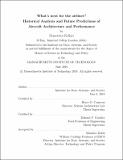What's next for the airliner? : historical analysis and future predictions of aircraft architecture and performance
Author(s)
Kellari, Demetrios
DownloadFull printable version (7.238Mb)
Alternative title
Historical analysis and future predictions of aircraft architecture and performance
Other Contributors
Technology and Policy Program.
Advisor
Bruce G. Cameron and Edward F. Crawley.
Terms of use
Metadata
Show full item recordAbstract
Air travel has advanced greatly since the inception of the first commercially viable airliner in the 1930s, the Douglas DC-3. In the 80 years since then, the number of annual air passengers in the US has increased from 6000 to over 800 million. In order to accommodate this demand growth, civil passenger aircraft architectures have changed over time, investment in aircraft technologies has rapidly increased, and aircraft performance has improved. The historical context of aircraft architectures are analyzed in order to establish trends and precedents for architectural change. This historical analysis is carried out based on a database of 157 architectures from the DC-3 to the Boeing 787, and concludes that historical aircraft architecture changes are mainly driven by selection of engine type. More recently aircraft performance has experienced diminishing returns in terms of efficiently, on the order of 1% reduction in fuel consumption annually since 2010. Meanwhile, according to projections by Airbus and Boeing, air passenger traffic is expected to increase 3.5-4.6% per annum. ICC has recommended that overall energy efficiently be reduced by 2% annually. The rate of increase in demand and decrease in fuel consumption, raises the question of how this goal can be met. Much prior work has been done to optimize design variables within the context of a single aircraft architecture for maximum performance. Additionally optimization of point designs at the corners of the architecture design space has also been extensively examined. Despite the abundance of work in this domain, there has been limited work done to understand the potential trajectories that would cause current architectures to evolve into these potential future architectures. Therefore, the goal of this thesis is to analyze the conditions that could break the current architecture of commercial aircraft. and identify the stringency of policies that could invoke such a disruption. To answer this research question, the major drivers of increasing engine perfor- mance are identified including increasing bypass ratio, increasing overall pressure ratio and turbine inlet temperature, and increasing component efficiently. A hybrid analytical-empirical model is presented optimizing the airframe-engine interactions. This model enables us to quantitatively forecast the impact of four engine technology scenarios on the mission block fuel. Results indicate that for existing airframes, namely the 737 and A320, performance is expected to increase by 6-38% relative to the 737MAX and A320neo within the next 10-14 years, depending on engine technology development. For a new aircraft with the dominant architecture and unconstrained geometry, we expect a performance increase of 17-40% versus an optimized aircraft with current technology. The maximum performance is expected to occur in the next 20-30 years, suggesting that a break in the dominant architecture will occur in this timeframe. Finally, two policy scenarios based on ICAO and IATA targets are shown to incentivize technology development, reduce the uncertainty in performance and architecture predictions, and reduce the time to an expected break in architecture.
Description
Thesis: S.M. in Technology and Policy, Massachusetts Institute of Technology, School of Engineering, Institute for Data, Systems, and Society, Technology and Policy Program, 2016. This electronic version was submitted by the student author. The certified thesis is available in the Institute Archives and Special Collections. Cataloged from student-submitted PDF version of thesis. Includes bibliographical references (pages 135-143).
Date issued
2016Department
Massachusetts Institute of Technology. Engineering Systems Division; Massachusetts Institute of Technology. Institute for Data, Systems, and Society; Technology and Policy ProgramPublisher
Massachusetts Institute of Technology
Keywords
Institute for Data, Systems, and Society., Engineering Systems Division., Technology and Policy Program.